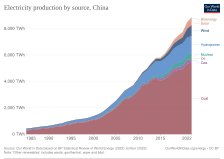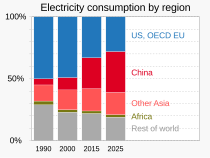 | |
| Data | |
|---|---|
| Installed capacity (2023) | 2919 GW |
| Production (2021) | 8.5 petawatt-hour (PWh) |
China is the world's largest electricity producer, having overtaken the United States in 2011 after rapid growth since the early 1990s. In 2021, China produced 8.5 petawatt-hour (PWh) of electricity, approximately 30% of the world's electricity production.[2]
Most of the electricity in China comes from coal power, which accounted for 62% of electricity generation in 2021[2] and is a big part of greenhouse gas emissions by China. Power generated from renewable energy has also been continuously increasing in the country, with national electricity generation from renewable energy reaching 594.7 TWh in Q1 2023, an increase of 11.4% year-on-year, including 342.2 TWh of wind and solar power, up 27.8% year-on-year.[3]
In 2023, China's total installed electric generation capacity was 2.92 TW,[4] of which 1.26 TW renewable, including 376 GW from wind power and 425 GW from solar power.[3] As of 2023, the total power generation capacity for renewable energy sources in China is at 53.9%.[5] The rest was mostly coal capacity, with 1040 GW in 2019.[6] Nuclear also plays an increasing role in the national electricity sector. As of February 2023, China has 55 nuclear plants with 57 GW of power in operation, 22 under construction with 24 GW and more than 70 planned with 88 GW. About 5% of electricity in the country comes from nuclear energy.[7]
China has two wide area synchronous grids, the State Grid and the China Southern Power Grid. The northern power grids were synchronized in 2005.[8] Since 2011 all Chinese provinces are interconnected. The two grids are joined by HVDC back-to-back connections.[9]
China has abundant energy reserves with the world's fourth-largest coal reserves and massive hydroelectric resources. There is however a geographical mismatch between the location of the coal fields in the north-east (Heilongjiang, Jilin, and Liaoning) and north (Shanxi, Shaanxi, and Henan), hydropower in the south-west (Sichuan, Yunnan, and Tibet), and the fast-growing industrial load centers of the east (Shanghai-Zhejiang) and south (Guangdong, Fujian).[10][better source needed]
- ^ "Electricity Market Report 2023" (PDF). IEA.org. International Energy Agency. February 2023. p. 15. Archived (PDF) from the original on 15 March 2023. Licensed CC BY 4.0.
- ^ a b https://www.bp.com/content/dam/bp/business-sites/en/global/corporate/pdfs/energy-economics/statistical-review/bp-stats-review-2022-full-report.pdf
- ^ a b "China's first desert-based green power plant on grid - Chinadaily.com.cn" (in Chinese). Global.chinadaily.com.cn. 28 April 2023. Retrieved 5 June 2023.
- ^ "China's installed solar power capacity rises 55.2% in 2023". Reuters.
- ^ Yin, Ivy (24 January 2024). "Coal still accounted for nearly 60% of China's electricity supply in 2023: CEC".
- ^ "Corrected-China to cap 2020 coal-fired power capacity at 1,100 GW". Reuters. 18 June 2020. Retrieved 5 January 2021.[dead link]
- ^ "How Long Will It Take For China's Nuclear Power To Replace Coal?". Forbes.com. Retrieved 5 June 2023.
- ^ Wu, Wei; He, Zhao; Guo, Qiang (June 2005). "China power grid and its future development". IEEE Power Engineering Society General Meeting, 2005. pp. 1533–1535. doi:10.1109/pes.2005.1489157. ISBN 0-7803-9157-8. S2CID 30004029.
- ^ Zhenya, Liu (28 August 2015). Global energy interconnection. Academic Press. p. 45. ISBN 9780128044063.
After the completion and commissioning of Tibet's ±400 kV DC interconnected power grid in December 2011, China has achieved nationwide interconnections covering all its territories other than Taiwan.
- ^ Kambara, Tatsu (1992). "The Energy Situation in China". The China Quarterly. 131 (131): 608–636. doi:10.1017/S0305741000046312. ISSN 0305-7410. JSTOR 654899. S2CID 154871503.

